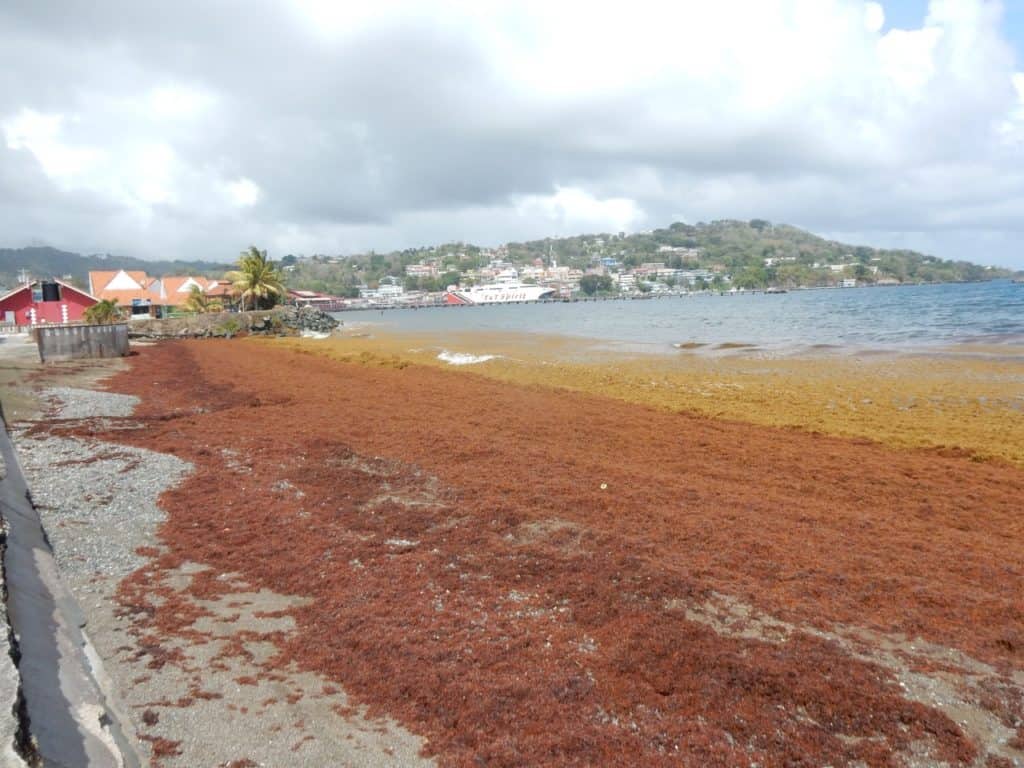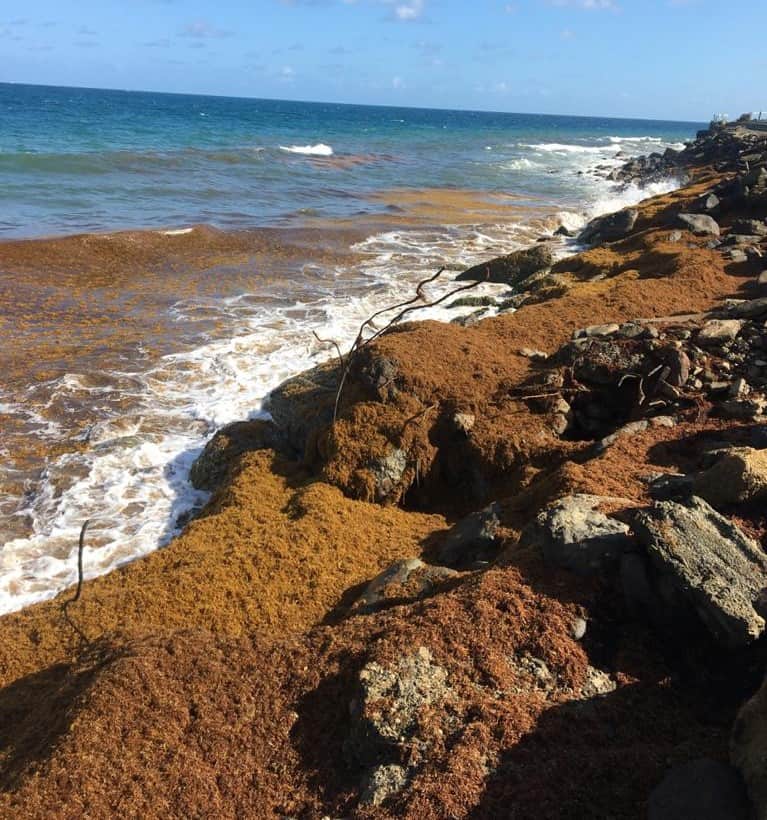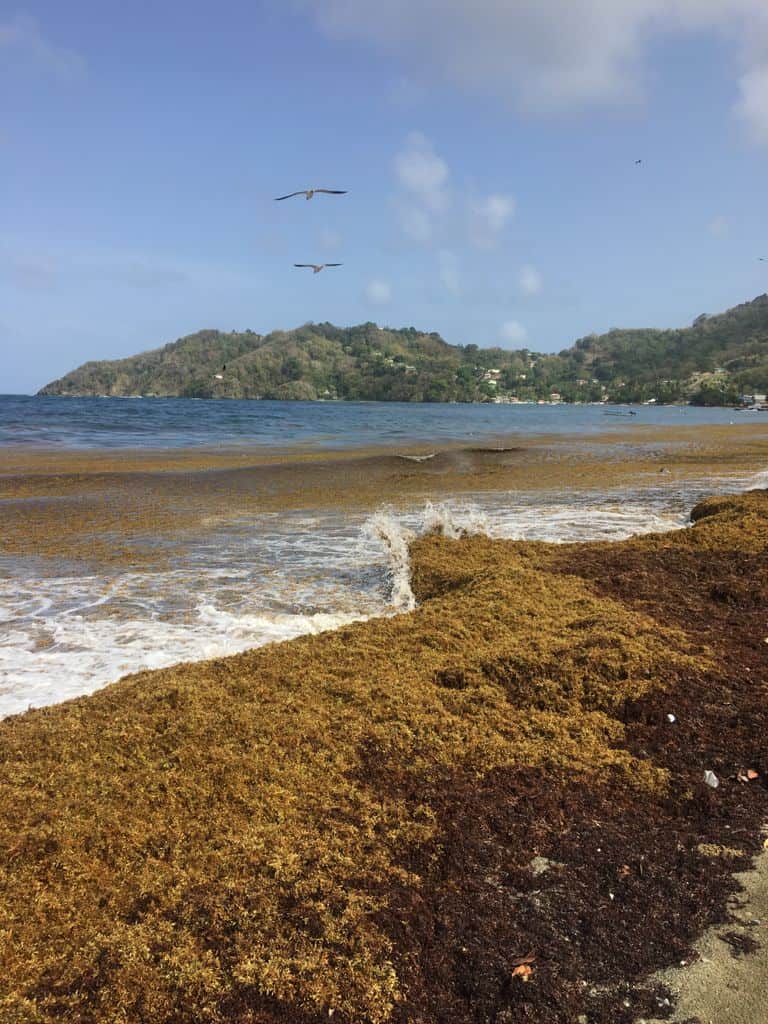Several beaches in Tobago have once again been rendered unrecognisable by large clusters of sargassum seaweed washing ashore. The issue was recently highlighted by a team of Institute of Marine Affairs (IMA) researchers who were in Tobago to conduct some monitoring work. The IMA advised via social media that their team had “noticed a significant amount of sargassum” washing up on the shores of Little Rockly Bay, located along Atlantic coast of the island where the impact of brown macroalgae is felt most accutely. As the sargassum issue continues to evolve into a seasonal crisis for many Caribbean islands dependent on tourism, more and more people have begun asking questions about the phenomenon’s origin. Why it is occurring? Can we do anything to stop it? Can sargassum seaweed be put to good use? Here is a run-through of what you need to know.
What is Sargassum?
Sargassum is a brown algae, or seaweed that floats free in the ocean and never attaches to the ocean floor. These free-floating forms are found primarily in the Atlantic Ocean. Sargassum provides refuge for migratory species and essential habitat for around 120 species of fish and more than 120 species of invertebrates. It’s an important nursery-type habitat that provides shelter and food for endangered species such as sea turtles and for commercially important species of fish such as tunas.

There are two species of Sargassum involved in the Sargassum influx: Sargassum natans and Sargassum fluitans. In this sense, it can almost serve as an eco-system in it’s own regard. Unfortunately, Sargassum also tends to accumulate marine debris like plastic within its entangled mass, increasing the chances of ingestion by fish and other organisms living there. As implied by the name, Sargassum seaweed comes from the Sargasso Sea. This is a geographic area identified as being in the Mid to North Atlantic Ocean.
This is an ecologically important area in the mid-Atlantic where traditionally, masses of seaweed have been encountered. Another interesting point to note is that the ocean is very warm in that area. While all other seas in the world are defined at least in part by land boundaries, the Sargasso Sea is defined only by ocean currents, which is quite fitting given the nomadic characteristics of Sargassum seaweed itself.

The warm sea water and many nutrients are the Sargassum equivalent of wine and candlelight, well not as romantic of course, but with more interesting and effective results. This is ideal for asexual reproduction by fragmentation, when wind, waves, animals or boats break up the floating mats, small pieces grow into larger ones. Given the right conditions, fragments of Sargassum can span acres of the ocean’s surface.
The seaweed en masse, when it arrives from it’s travels on the sea, holds generally a quite unique but pungent scent, which is as a result of the constant interaction with salt, and or other microorganisms that are picked up along the way. So if you visit beaches, even where it is considered to be among the most remote areas of Tobago (Speyside a prime example), you may have encountered piles of the “stinky” seaweed.
Landfall and its effects
The obvious presence of Sargassum in coastal regions, and on local beaches is very much a bothersome occurrence to those that populate those regions of not only Tobago, but the Caribbean in general. People such as fisher-folk, tour operators, and beachfront business owners, and tourism reliant industries (sun – sand – sea establishments) usually complain that this is a hindrance to their product, and favorable output.
More to the description of Sargassum, the hefty amounts that have made their way to the Tobago’s shorelines, have since been flagged by local agencies such as TEMA (Tobago Environmental Management Authority) as a serious risk, for boat operators, those dependent on the marine environment for a livelihood, and even for the simple beach-going enthusiast visiting the island to enjoy a day of recreation.
Boat operators experience a certain measure of difficulty in getting close to land and performing functions that they would normally have a seamless process in executing. The cleanup of such large deposits or buildup of seaweed on the shoreline is always seen by locals as a tedious task, considering it would require mobilization of resources such as man power, extraction procedures and tools necessary to execute such an operation effectively.

While Sargassum is currently seen as a nuisance, somewhere deep within its tangles and tendrils are opportunities for affected countries, particularly the small island developing states in the Caribbean. With research, will-power, good old elbow grease, and a pair of gloves, this seaweed has the potential to boost economies, as well as create entirely new industries. I can’t tell when plans for laying on the beach, sipping cocktails on the sand and bathing in weed-free sea will become a reality (with Covid19 still lurking and all). The more pressing question is, what will we do next time there is a Sargassum invasion on our shores?
Turning a “Plague” into something beneficial
Going forward and looking into the future, we can find innovative ways to monetize the plague. Sargassum has great potential to be used as a form of biofuel. Biofuel is produced through biological processes, such as agriculture and anaerobic digestion, rather than a fuel produced by geological processes such as those involved in the formation and extraction of fossil fuels, such as coal and petroleum.
With a global swing in the type of fuels being explored for use, the introduction of a new form of renewable energy is always encouraged. This is a step in the right direction of a ‘green’ way of thinking and doing. What if Caribbean governments both on individual and collaborative levels, can invest in this opportunity post pandemic, we may be on to something as a region that opens even more doors for sustainable development and by extension economic growth.
Other opportunities for existing industries
In relation to a simple fix to a recurring issue, why not use Sargassum for all that it’s worth? Sargassum absorbs, stores and transports significant amounts of sea salt. Added to that it is rich in nutrients which makes a wonderful source of fertilizer for plants.The fertilizer is a very old idea since many local farmers and gardeners go to the coastal areas with a view of small scale mining the seaweed, for their very own agricultural output and enhancement.
Another far fetched action within reasonable reach for the region, is a marine or “on sea” extraction operation (this may begin at a small scale or level) but there is room for expansion of such an idea. The way this works is to have a designated area in the marine space, sufficiently far off from the coast to capture expanses of Sargassum. This can even further prevent landfall and by extension save much needed mobilization of resources on cleanup efforts.
Sargassum seaweed and even plastics and other harmful debris can be collected by deployment of a customized floating offshore barrier, then collected by boats and repurposed or recycled in an environmentally friendly (eco-friendly) manner. If properly constructed, and operationalized, marine life is not adversely affected, (in the case of sea turtles among others) Sargassum control efforts prove to have great advantages not just for Caribbean economies, but for the our citizens’ and their enjoyment of the simple pleasures of island living.




![Woman Taking picture of Great Blue Heron with a smart phone in the Florida Everglades [jjneff Getty Images Signature © CANVA]](https://www.caribois.org/wp-content/uploads/2021/04/Untitled-design-2021-04-28T122503.917-75x75.png)
